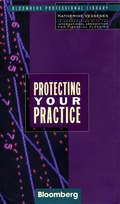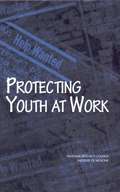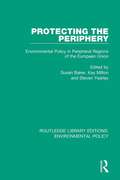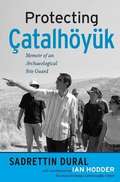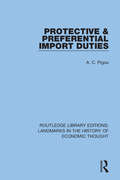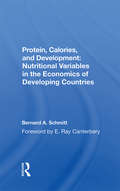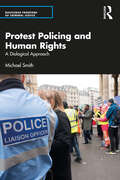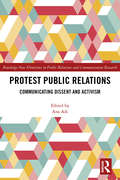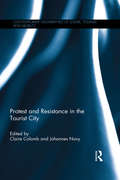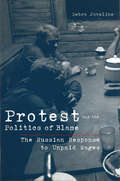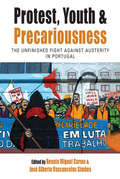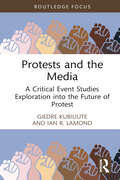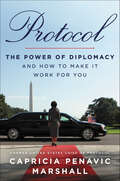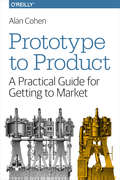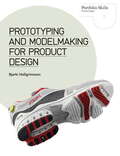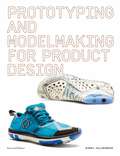- Table View
- List View
Protecting Your Practice (Bloomberg Financial #17)
by Katherine VessenesThis is the benchmark book for building client relationships, growing a practice, and avoiding litigation--written in association with the world's leading organization for financial services professionals. Audience: Broker-dealers and their home-office personnel, registered reps, accountants, tax advisers, insurance agents and insurance companies, wire houses, fee and commission planners, attorneys, trust officers, estate planners, and development officers in planned-giving departments. As investors gravitate toward no-load mutual funds and do-it-yourself investing through discount brokers, professionals are being squeezed by competition, consumer wariness, and tighter enforcement by the SEC, NASD, and state securities regulators. This book addresses these challenges, helping anyone offering financial advice to be more competitive, build client loyalty, and avoid the liabilites that come with managing someone's money in today's complex investment environment. How to offer better service, comply with key regulations, maintain vital records with a minimum of paperwork, and protect a business from malpractice claims.
Protecting Youth at Work: Health, Safety, and Development of Working Children and Adolescents in the United States
by Committee on the Health Safety Implications of Child LaborIn Massachusetts, a 12-year-old girl delivering newspapers is killed when a car strikes her bicycle. In Los Angeles, a 14-year-old boy repeatedly falls asleep in class, exhausted from his evening job. Although children and adolescents may benefit from working, there may also be negative social effects and sometimes danger in their jobs.Protecting Youth at Work looks at what is known about work done by children and adolescents and the effects of that work on their physical and emotional health and social functioning. The committee recommends specific initiatives for legislators, regulators, researchers, and employers.This book provides historical perspective on working children and adolescents in America and explores the framework of child labor laws that govern that work. The committee presents a wide range of data and analysis on the scope of youth employment, factors that put children and adolescents at risk in the workplace, and the positive and negative effects of employment, including data on educational attainment and lifestyle choices.Protecting Youth at Work also includes discussions of special issues for minority and disadvantaged youth, young workers in agriculture, and children who work in family-owned businesses.
Protecting the Periphery: Environmental Policy in Peripheral Regions of the European Union (Routledge Library Editions: Environmental Policy #1)
by Steven Yearley Susan Baker Kay MiltonFirst published in 1994. ln Protecting the Periphery the editors present a series of papers revealing the impact of EU policies on environmental quality in regions at the edge of the European Union and in those lying just outside it. In many cases these regions contain habitats and landscapes of international importance; they have also often escaped some of the environmental damage caused by industrialization. But, as the papers' reveal, attempts by the EU to safeguard these environmental benefits are often contradicted by the EU’s own development policies, bringing air pollution from new roads, contamination from new industries, and leading to habitat destruction from modern agricultural practices and increases in tourism. As the Union pushes for the deepening of the integration process, including completing the internal market, the pressures on the periphery's environment are increasing. Furthermore, the efforts of the periphery to catch-up economically with the developed core can often heighten the tension between economic considerations on the one hand and the need for environmental protection on the other. The studies in this book examine the ambivalent responses to EU environmental policy among policy-makers and environmentalists in the periphery. Both the willingness as well as the capacity of the periphery to protect its environmental heritage are explored. In particular, the administrative capacity, institutional arrangements, political culture as well as economic development needs are taken into account in an examination of the nature of the periphery’s response to and implementation of Union environmental policy. The book will appeal to policy-makers and academics in the countries of the European periphery and to analysts of European policy-making everywhere, especially those concerned with environmental policy and politics.
Protecting Çatalhöyük: Memoir of an Archaeological Site Guard
by Sadrettin Dural Ian HodderThey are essential to every major archaeological excavation but rarely acknowledged by the visiting researchers once the artifacts have been shipped. As part of the innovative, multivocal output from the famous Turkish Neolithic site of Çatalhöyük, we hear from one of the site guards, Sadrettin Dural, who tells the story of the excavation from the point of view of the 'Other'. He offers tales of the strange habits of archaeologists, describes the local in-fighting that scholars never see, and explains how scientists can be protected from the Yatirs, spirits of the dead who guard the mound. Ian Hodder, director of the Çatalhöyük project, provides explanatory notes for the reader and an interview with the author, exploring indigenous interpretations of ancient sites and the archaeologists who excavate them. For the archaeologist, this offers a revolutionary new viewpoint on their work. For the cultural anthropologist, Dural's role as site guard is only a small part of his life as a Turkish villager. The author recounts the daily lived experience of one man in a contemporary Turkish village, including changing economic strategies for supporting his family, brushes with the law, trips to the beach and the city, and Turkish phone sex.
Protection Amid Chaos: The Creation of Property Rights in Palestinian Refugee Camps (Columbia Studies in Middle East Politics)
by Nadya HajjThe right to own property is something we generally take for granted. For refugees living in camps, in some cases for as long as generations, the link between citizenship and property ownership becomes strained. How do refugees protect these assets and preserve communal ties? How do they maintain a sense of identity and belonging within chaotic settings?Protection Amid Chaos follows people as they develop binding claims on assets and resources in challenging political and economic spaces. Focusing on Palestinians living in refugee camps in Lebanon and Jordan, it shows how the first to arrive developed flexible though legitimate property rights claims based on legal knowledge retained from their homeland, subsequently adapted to the restrictions of refugee life. As camps increased in complexity, refugees merged their informal institutions with the formal rules of political outsiders, devising a broader, stronger system for protecting their assets and culture from predation and state incorporation. For this book, Nadya Hajj conducted interviews with two hundred refugees. She consults memoirs, legal documents, and findings in the United Nations Relief Works Agency archives. Her work reveals the strategies Palestinian refugees have used to navigate their precarious conditions while under continuous assault and situates their struggle within the larger context of communities living in transitional spaces.
Protection of Health and Safety at the Workplace: A Comparative Legal Study of the European Union and China
by Kai LiuThis book investigates four core characteristics of occupational health and safety legal systems in order to provide a comparative and critical analysis of the similarities and differences in protecting the health and safety of workers at the workplace. In addition to analysing the health and safety regulations, the book addresses corresponding oversight and enforcement mechanisms. It compares and contrasts five different legal systems, namely those of the EU, the Netherlands, the UK, Sweden and China. Beyond offering an overview of the modes of OHS regulation, instruments and legal enforcement practices, the book helps to answer the question of how to improve working environments in order to protect workers from all kinds of dangers encountered at the workplace. The intended readership includes researchers with a background in labour law, comparative law, Chinese law and/or European Union law.
Protection of Intellectual Property in the United States
by Howard Zaharoff Myra M. HartPresents an overview of U.S. laws/systems in place to safeguard intellectual property rights. Includes a brief history of the development of the laws. Attention is given to patents, licenses, copyrights, trade secrets, trade and service markets, and non-disclosure and non-compete agreements.
Protection or Free Trade: An Examination of the Tariff Question, With Especial Regard to the Interests of Labour (Routledge Library Editions: International Trade Policy #21)
by Henry GeorgeIn this book, first published in 1890, the author endeavours to determine whether protectionism or free trade better accords with the interests of labour – particularly with regards to the raising of wages. He analyses the popularity of protection in the face of the evidence of its fallacies, and examines the principle of free trade and its consequences.
Protective Operations: A Handbook for Security and Law Enforcement
by Glenn McGovernA reference for law enforcement and security organizations tasked with protecting the welfare of an individual or groups of individuals, this volume offers suggestions and guidance for confronting high-threat scenarios as well as the more mundane protective details. Detailing the essence of protective operations that are run, in large part, covertly, the book explores operational security, situational awareness, and surveillance detection and includes examples from real-world attacks occurring over the past sixty years. Focusing on the economics of providing the most protection for the least cost, it also addresses issues surrounding possible direct violations of the law and department policy and procedures.
Protective and Preferential Import Duties (Routledge Library Editions: Landmarks in the History of Economic Thought)
by A. C. PigouA.C. Pigou spent his career in the shadow of Marshall and Keynes and his contributions have seemed small by comparison, but his influence remains significant. He is regarded by many as the father of modern public finance and welfare theory, as the way that economists analyze and justify government intervention in economic affairs stems from Pigou. Following on from A. C. Pigou’s 1903 pamphlet, The Riddle of the Tariff, this book, originally published in 1906, is a more technical treatment, leaning on the Marshalian apparatus and coming out against the policy of Imperial preference.
Protege Partners: The Capacity Challenge
by Randolph B. Cohen Brian J. DelaceyIn February 2005, Jeffrey Tarrant (HBS '85) and Ted Seides (HBS '99) considered their strategy for Protege Partners, founded in July 2002 as a fund of hedge funds (FOHF) specializing in small hedge funds. Protege's assets under management had grown to $1.1 billion, and Protege's development almost exactly mirrored the founders' expectations from 2001. Although the founders saw benefits to growth, they remained committed to the integrity of managing a small fund and wanted to continue generating superior performance for their clients. Should they close the Protege FOHF to new investors and focus on managing the existing assets as they originally intended? Could they continue to increase assets under management without taking on more top-level professionals? Should they hire additional analytical staff to help them grow Protege? Should they leverage Protege's special relationships with seeded managers to create a multistrategy hedge fund? Perhaps most important, how would their valued clients react to change?
Protein, Calories, And Development: Nutritional Variables In The Economics Of Developing Countries
by Bernard SchmittProduction of world food supplies is related to more complicated socioeconomic variables than have previously been analyzed. Besides traditional inputs of land, labor, and fertilizer, the technological capabilities and a variety of nutritional and other human capital components are significant independent variables in explaining agricultural production in the developing world. The integration of economic analyses with the concepts of nutritional science offers an expanded and effective means for analyzing the complex problems of agricultural production in nutritionally deficient countries. Bernard Schmitt traces the circular relationship between nutrition and human capital, labor productivity, food production, and per capita consumption of calories and protein. He defines the basic nutritional terms that are most useful to economists in analyzing agricultural and foodrelated questions and provides examples that stress the importance of concentrating on nutritional quality as well as gross quantity. Transformations are used to convert quantities into basic nutritional components, allowing more meaningful quantitative analyses in an econometric framework. Dr. Schmitt presents a flexible methodology for forecasting commodity production, using it to make projections for the developing countries for each major commodity group and to test various policy alternatives such as extensive trade, expanded food assistance programs, substantial resource or input expansion, further expansion of Green Revolution technology, and development of alternatives to agriculture. Although he is certain that gains can be accomplished through population control and agricultural advances, supplemented by alternative nutritional sources, he concludes that conditions in nutritionally deficient countries are unlikely to improve, on average, through the mid-1980s.
Protest Policing and Human Rights: A Dialogical Approach (Routledge Frontiers of Criminal Justice)
by Michael SmithThis book examines protest policing and the toolbox of options available to police commanders in response. The right to peacefully protest is intrinsic to democracy and embedded in British history and tradition. The police are responsible for managing public order and facilitating peaceful protest and this has not been without criticism. On occasions, the police have found themselves in opposition to protest groups and there have been incidents of disorder as a result. In response, the development of Police Liaison Teams in the UK has presented the police with a gateway for dialogue between themselves and those involved in protest. Drawing on two contrasting case studies, the policing of the badger cull in South West England and an English Defence League (EDL) march in Liverpool, this book explores the experiences of police commanders, police liaison officers, protesters, counterdemonstrators, members of local businesses and other interested parties. It explores how a dialogical approach with all those engaged in or affected by a protest has assisted the police in balancing human rights and reducing conflict for all. An accessible and compelling read, this book will appeal to students, scholars and practitioners of policing, politics, criminology, sociology, human rights and all those interested in how protests are policed.
Protest Politics in the Marketplace: Consumer Activism in the Corporate Age
by Caroline HeldmanProtest Politics in the Marketplace examines how social media has revolutionized the use and effectiveness of consumer activism. In her groundbreaking book, Caroline Heldman emphasizes that consumer activism is a democratizing force that improves political participation, self-governance, and the accountability of corporations and the government. She also investigates the use of these tactics by conservatives.Heldman analyzes the democratic implications of boycotting, socially responsible investing, social media campaigns, and direct consumer actions, highlighting the ways in which such consumer activism serves as a countervailing force against corporate power in politics. In Protest Politics in the Marketplace, she blends democratic theory with data, historical analysis, and coverage of consumer campaigns for civil rights, environmental conservation, animal rights, gender justice, LGBT rights, and other causes. Using an inter-disciplinary approach applicable to political theorists and sociologists, Americanists, and scholars of business, the environment, and social movements, Heldman considers activism in the marketplace from the Boston Tea Party to the present. In doing so, she provides readers with a clearer understanding of the new, permanent environment of consumer activism in which they operate.
Protest Public Relations: Communicating dissent and activism (Routledge New Directions in PR & Communication Research)
by Ana AdiGlobal movements and protests from the Arab Spring to the Occupy Movement have been attributed to growing access to social media, while without it, local causes like #bringbackourgirls and the ice bucket challenge may have otherwise remained unheard and unseen. Regardless of their nature – advocacy, activism, protest or dissent – and beyond the technological ability of digital and social media to connect support, these major events have all been the results of excellent communication and public relations. But PR remains seen only as the defender of corporate and capitalist interests, and therefore resistant to outside voices such as activists, NGOs, union members, protesters and whistle-blowers. Drawing on contributions from around the world to examine the concepts and practice of "activist," "protest" and "dissent" public relations, this book challenges this view. Using a range of international examples, it explores the changing nature of protest and its relationship with PR and provides a radical analysis of the communication strategies and tactics of social movements and activist groups and their campaigns. This thought-provoking collection will be of interest to researchers and advanced students of public relations, strategic communication, political science, politics, journalism, marketing, and advertising, and also to PR professionals in think tanks and NGOs.
Protest and Organization in the Alternative Globalization Era
by Heather GautneyThis study looks at the ongoing efforts of the Alternative Global Movement and World Social Forum to reconcile contests over political organization among three of the most prominent groups on the contemporary left - social and liberal democratic NGOs, anti-authoritarian (anarchist) social movements, and political parties.
Protest and Resistance in the Tourist City (Contemporary Geographies of Leisure, Tourism and Mobility)
by Claire Colomb Johannes NovyAcross the globe, from established tourist destinations such as Venice or Prague to less traditional destinations in both the global North and South, there is mounting evidence that points to an increasing politicization of the topic of urban tourism. In some cities, residents and other stakeholders take issue with the growth of tourism as such, as well as the negative impacts it has on their cities; while in others, particular forms and effects of tourism are contested or deplored. In numerous settings, contestations revolve less around tourism itself than around broader processes, policies and forces of urban change perceived to threaten the right to ‘stay put’, the quality of life or identity of existing urban populations. This book for the first time looks at urban tourism as a source of contention and dispute and analyses what type of conflicts and contestations have emerged around urban tourism in 16 cities across Europe, North America, South America and Asia. It explores the various ways in which community groups, residents and other actors have responded to – and challenged – tourism development in an international and multi-disciplinary perspective. The title links the largely discrete yet interconnected disciplines of ‘urban studies’ and ‘tourism studies’ and draws on approaches and debates from urban sociology; urban policy and politics; urban geography; urban anthropology; cultural studies; urban design and planning; tourism studies and tourism management. This ground breaking volume offers new insight into the conflicts and struggles generated by urban tourism and will be of interest to students, researchers and academics from the fields of tourism, geography, planning, urban studies, development studies, anthropology, politics and sociology.
Protest and the Politics of Blame: The Russian Response to Unpaid Wages
by Debra JavelineThe wage arrears crisis has been one of the biggest problems facing contemporary Russia. At its peak, it has involved some $10 billion worth of unpaid wages and has affected approximately 70 percent of the workforce. Yet public protest in the country has been rather limited. The relative passivity of most Russians in the face of such desperate circumstances is a puzzle for students of both collective action and Russian politics. In Protest and the Politics of Blame, Debra Javeline shows that to understand the Russian public's reaction to wage delays, one must examine the ease or difficulty of attributing blame for the crisis. Previous studies have tried to explain the Russian response to economic hardship by focusing on the economic, organizational, psychological, cultural, and other obstacles that prevent Russians from acting collectively. Challenging the conventional wisdom by testing these alternative explanations with data from an original nationwide survey, Javeline finds that many of the alternative explanations come up short. Instead, she focuses on the need to specify blame among the dizzying number of culprits and potential problem solvers in the crisis, including Russia's central authorities, local authorities, and enterprise managers. Javeline shows that understanding causal relationships drives human behavior and that specificity in blame attribution for a problem influences whether people address that problem through protest. Debra Javeline is Assistant Professor of Political Science, Rice University.
Protest, Youth and Precariousness: The Unfinished Fight against Austerity in Portugal (Protest, Culture & Society #27)
by Renato Miguel Carmo José Alberto Vasconcelos SimõesAfter over a decade of the austerity measures that followed the 2008 financial crisis—entailing severe, unpopular policies that have galvanized opposition and frayed social ties—what lies next for European societies? Portugal offers an interesting case for exploring this question, as a nation that was among the hardest hit by austerity and is now seeking a fresh path forward. This collection brings together sociologists, social movement specialists, political scientists, and other scholars to look specifically at how Portuguese youth have navigated this politically and economically difficult period, negotiating uncertain social circumstances as they channel their discontent into protest and collective action.
Protests and the Media: A Critical Event Studies Exploration into the Future of Protest (ISSN)
by Ian R. Lamond Giedre KubiliuteThis insightful volume critically explores activist events in their scale and their capacity to attract media attention through a critical event studies lens, offering new perspectives on protests and social movement.This book conceives events of dissent as the public manifestation of counter-narratives that articulate advocacy for policy change. It focuses on the material and virtual manifestation of protest events and the media response to them, associated with three active social movements – Reclaim These Streets, Extinction Rebellion, and Black Lives Matter. In doing so, the text sheds light on how different political orientations within the media articulate the representation of events of dissent manifest by these groups, and how this results in significantly different opinion-forming statements on the issues behind those movements, as well as how this reflects mediated assessment of the responses of politicians, the public, and emergency service responses to protest events. Furthermore, it will explore the role of the Internet in the organisation of protest events and their part in the formation of networks of resistance, enabling the roll out of events with a global reach – demonstrated, more recently, by protests across many European cities against the war in Ukraine.This timely and significant book will appeal to scholars of and those interested in events tourism, protest, political communication, and media, amongst others.
Protocol: The Power of Diplomacy and How to Make It Work for You
by Capricia Penavic MarshallPresident Obama’s former United States chief of protocol looks at why diplomacy and etiquette matter—and how they can help you in everyday life.In her roles as chief of protocol for President Barack Obama and social secretary to President Bill Clinton and First Lady Hillary Clinton, Capricia Penavic Marshall not only bore witness to history, but she also facilitated it. From curating rooms to have an intended impact to knowing which cultural gestures earned trust, her detailed measures were superpower influences that laid the groundwork for successful diplomacy between leaders and tilted the advantage, always, in her team’s favor. Sharing unvarnished anecdotes of harrowing near misses and exhilarating triumphs, Marshall offers the master class in soft power.Praise for Protocol“A trusted friend and a trusted colleague. I can’t imagine anyone who has been a greater public servant.” —Hillary Clinton“Working with Capricia during the Obama administration was nothing short of wonderful! Her guiding hand and innovative methods laid the foundation for our successful diplomacy on the world stage.” —Valerie Jarrett, former senior advisor to Barack Obama and author of Finding My Voice“Fascinating. . . . An informative and often charming primer on a little-known—but vital—government post.” —Kirkus Reviews
Prototype to Product: A Practical Guide for Getting to Market
by Alan CohenProduct development is the magic that turns circuitry, software, and materials into a product, but moving efficiently from concept to manufactured product is a complex process with many potential pitfalls. This practical guide pulls back the curtain to reveal what happens—or should happen—when you take a product from prototype to production.For makers looking to go pro or product development team members keen to understand the process, author Alan Cohen tracks the development of an intelligent electronic device to explain the strategies and tactics necessary to transform an abstract idea into a successful product that people want to use.Learn 11 deadly sins that kill product development projectsGet an overview of how electronic products are manufacturedDetermine whether your idea has a good chance of being profitableNarrow down the product’s functionality and associated costsGenerate requirements that describe the final product’s detailsSelect your processor, operating system, and power sourcesLearn how to comply with safety regulations and standardsDive into development—from rapid prototyping to manufacturingAlan Cohen, a veteran systems and software engineering manager and lifelong technophile, specializes in leading the development of medical devices and other high-reliability products. His passion is to work with engineers and other stakeholders to forge innovative technologies into successful products.
Prototyping and Modelmaking for Product Design: Second Edition
by Bjarki HallgrimssonBuilding prototypes and models is an essential component of any design activity. Modern product development is a multi-disciplinary effort that relies on prototyping in order to explore new ideas and test them sufficiently before they become actual products. Prototyping and Modelmaking for Product Designers illustrates how prototypes are used to help designers understand problems better, explore more imaginative solutions, investigate human interaction more fully and test functionality so as to de-risk the design process. Following an introduction on the purpose of prototyping, specific materials, tools and techniques are examined in detail, with step-by-step tutorials and industry examples of real and successful products illustrating how prototypes are used to help solve design problems. Workflow is also discussed, using a mixture of hands-on and digital tools. A comprehensive modern prototyping approach is crucial to making informed design decisions, and forms a strategic part of a successful designer's toolkit.
Prototyping and Modelmaking for Product Design: Second Edition
by Bjarki HallgrimssonNow in its second edition, Prototyping and Modelmaking for Product Design, by practising product development consultant Bjarki Hallgrimsson, is essential reading for both students and design professionals.Prototyping and ModelMaking for Product Design goes behind the scenes to illustrates how prototypes are used to help designers understand problems better, explore more imaginative solutions, investigate human interaction more fully and test functionality so as to de-risk the design process. Following an introduction on the purpose of prototyping, specific materials, tools and techniques are examined in detail, with step-by-step tutorials and industry examples of real and successful products illustrating how prototypes are used to help solve design problems. Workflow is also discussed, using a mixture of hands-on and digital tools.This new edition includes case studies representing technological developments such as prototyping user experience and interactive electronic products, as well as a new expanded section on digital modelmaking tools, including 3D printing and laser cutting.The first chapters of the book explain why prototyping is so important to the design process. The many uses of prototyping will be shown in the context of several comprehensive projects by some of the world's leading design firms.The second part is an introduction to the typical materials used by designers in their prototyping efforts and how to work with them. In all cases, the approach is to use digital and manual tools in a complementary and effective fashion. Tutorials were specifically developed that underline the back and forth of digital and manual ways of working. The emphasis is on the kinds of construction that can be done by the designers themselves. Health and safety is stressed in terms of personal responsibility and awareness.Topics covered include:Definition of prototyping and modelmakingPrototyping as a form of problem solvingModelmakingPhysical and digital prototypesBuidling by hand and using digital technologies
Prototyping and Modelmaking for Product Design: Second Edition
by Bjarki HallgrimssonNow in its second edition, Prototyping and Modelmaking for Product Design, by practising product development consultant Bjarki Hallgrimsson, is essential reading for both students and design professionals.Prototyping and ModelMaking for Product Design goes behind the scenes to illustrates how prototypes are used to help designers understand problems better, explore more imaginative solutions, investigate human interaction more fully and test functionality so as to de-risk the design process. Following an introduction on the purpose of prototyping, specific materials, tools and techniques are examined in detail, with step-by-step tutorials and industry examples of real and successful products illustrating how prototypes are used to help solve design problems. Workflow is also discussed, using a mixture of hands-on and digital tools.This new edition includes case studies representing technological developments such as prototyping user experience and interactive electronic products, as well as a new expanded section on digital modelmaking tools, including 3D printing and laser cutting.The first chapters of the book explain why prototyping is so important to the design process. The many uses of prototyping will be shown in the context of several comprehensive projects by some of the world's leading design firms.The second part is an introduction to the typical materials used by designers in their prototyping efforts and how to work with them. In all cases, the approach is to use digital and manual tools in a complementary and effective fashion. Tutorials were specifically developed that underline the back and forth of digital and manual ways of working. The emphasis is on the kinds of construction that can be done by the designers themselves. Health and safety is stressed in terms of personal responsibility and awareness.Topics covered include:Definition of prototyping and modelmakingPrototyping as a form of problem solvingModelmakingPhysical and digital prototypesBuidling by hand and using digital technologies
